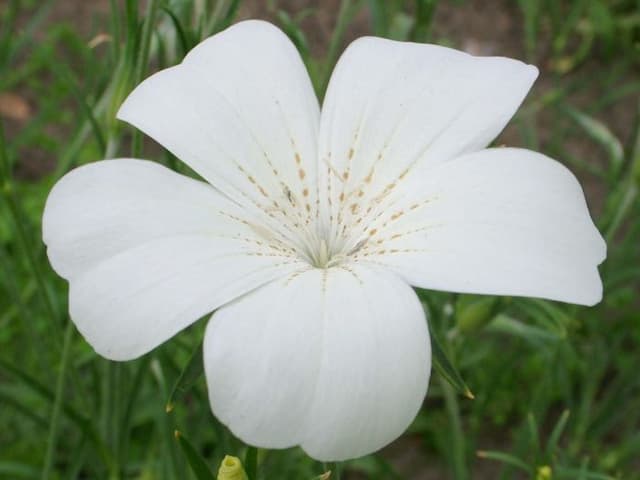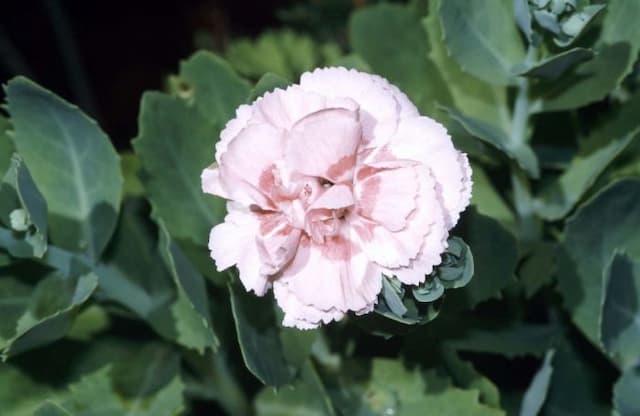Maiden Pink Dianthus deltoides

ABOUT
Dianthus deltoides, known as the Maiden Pink, is a charming perennial plant that boasts a bright and lively appearance. This species is characterized by its lush foliage and vibrant flowers. The leaves of the Maiden Pink are small, narrow, and form a dense mat of green, providing a lush groundcover. As for the blooms, they are quite striking—typically a deep pink or sometimes red, with a distinctive pattern of dots near the center and fringed petal edges that can sometimes appear as if they've been delicately cut with pinking shears. These flowers are organized in open clusters atop thin, erect stems, rising above the foliage to greet the sun. They possess a subtle fragrance that adds an additional layer of appeal to this visually striking plant. The Maiden Pink blooms profusely under ideal conditions, with the flowering period extending through the warmer months, bringing a splash of color to gardens and wild areas alike.
About this plant
 Names
NamesFamily
Caryophyllaceae
Synonyms
Maiden Pink, Maiden's Pink, Arctic Fire, Pinks
Common names
Dianthus arenarius subsp. deltoides, Dianthus deltoides subsp. condensatus, Dianthus deltoides subsp. deltoides, Dianthus deltoides subsp. degenii, Dianthus monspessulanus, Silene deltoides.
 Toxicity
ToxicityTo humans
Dianthus deltoides, commonly known as Maiden Pink, is not considered toxic to humans. There is no widespread evidence of toxicity or symptomatic poisoning in humans from ingesting or coming into contact with parts of the Maiden Pink plant.
To pets
Maiden Pink, or Dianthus deltoides, is also not recognized as toxic to pets. There are no significant reports of pet poisoning after ingestion of this plant. Therefore, it is not typically associated with toxic symptoms or harmful consequences for pets if they consume parts of the plant. However, it's always a good practice to prevent pets from eating plants as individual animals might have sensitivities or allergic reactions.
 Characteristics
CharacteristicsLife cycle
Perennials
Foliage type
Evergreen
Color of leaves
Dark green
Flower color
Pink
Height
6-12 inches (15-30 cm)
Spread
6-12 inches (15-30 cm)
Plant type
Herb
Hardiness zones
3-9
Native area
Europe
Benefits
 General Benefits
General Benefits- Aesthetic Appeal: Adds vibrant color and texture to gardens with its bright pink, white, or red flowers.
- Pollinator Attraction: Attracts bees, butterflies, and other beneficial insects that pollinate plants.
- Low Maintenance: Requires minimal care once established, making it ideal for busy gardeners.
- Drought Tolerance: Has the ability to withstand dry periods, reducing the need for frequent watering.
- Soil Erosion Control: Ground-covering nature prevents soil erosion by stabilizing the soil with its roots.
- Versatility: Suitable for rock gardens, borders, and as a ground cover, offering various landscaping uses.
- Deer Resistance: Less attractive to deer, which helps prevent damage to the plant and garden.
- Long Blooming: Produces flowers from late spring to early fall, providing extended seasonal interest.
 Medical Properties
Medical PropertiesThis plant is not used for medical purposes.
 Air-purifying Qualities
Air-purifying QualitiesThis plant is not specifically known for air purifying qualities.
 Other Uses
Other Uses- Cottage Garden Accent: Maidenhair pink, with its vibrant blooms, adds a splash of color to traditional cottage gardens, creating a picturesque and charming landscape.
- Erosion Control: Due to its mat-forming growth habit, this plant is used on slopes and banks to prevent soil erosion.
- Butterfly Garden Addition: The flowers of maidenhair pink attract butterflies, making it a perfect addition to butterfly gardens for conservation and enjoyment.
- Culinary Garnish: The edible flowers of maidenhair pink can be used as a decorative and colorful garnish in salads and desserts.
- Natural Fabric Dye: The petals of maidenhair pink can be used to create a natural dye for fabrics, offering hues of pink and red.
- Essential Oil Production: While not its most common use, the plant can be processed for its essential oil, which is used in perfumery and aromatherapy for its floral scent.
- Ground Cover: Its dense foliage makes it an effective ground cover that suppresses weeds and covers bare spots in gardens.
- Potpourri Ingredient: Dried petals of the maidenhair pink can be included in potpourri mixes for a pleasant fragrance in the home.
- Photography Subject: With its vivid flowers and low-growing habit, maidenhair pink is often photographed and used in botanical art and educational materials.
- Container Planting: Maidenhair pink can be planted in containers and pots, where its overflowing growth adds charm to balconies and patios.
Interesting Facts
 Feng Shui
Feng ShuiThe Maiden Pink is not used in Feng Shui practice.
 Zodiac Sign Compitability
Zodiac Sign CompitabilityThe Maiden Pink is not used in astrology practice.
 Plant Symbolism
Plant Symbolism- Divine Love: The genus name "Dianthus" comes from the Greek words "dios" (divine) and "anthos" (flower), implying the plant is the flower of the gods and symbolizes divine love.
- Admiration: Dianthus deltoides, commonly called Maiden Pink, often represents admiration due to its beautiful and intricate patterns that catch the eye.
- Boldness: The vibrant colors of Maiden Pink are often associated with boldness and daring, symbolizing a challenge to step forward with confidence.
- Pure Affection: In the language of flowers, pinks, a term that covers various Dianthus species, are associated with pure affection, signifying heartfelt emotion that goes beyond the physical.
- Zeal and Fervor: The fiery palette of some Maiden Pink varieties can also represent zealousness and fervor, suggesting a passionate commitment to a cause or belief.
 Water
WaterThe Maiden Pink (Dianthus deltoides) prefers consistent moisture, but it's essential not to overwater as it can tolerate some dryness. Water the Maiden Pink when the top inch of soil feels dry, generally once or twice a week, depending on weather conditions. Use a watering can or hose to gently water the soil at the base of the plant to avoid soaking the foliage, which can lead to fungal diseases. During the growing season, a weekly watering that provides approximately one gallon per square foot should suffice. In hotter, drier weather, increase watering frequency to keep the soil consistently moist but not waterlogged.
 Light
LightMaiden Pink thrives in full sun conditions, meaning it should receive at least six hours of direct sunlight daily. Plant your Dianthus deltoides in a location where it can enjoy unfiltered sunlight through most of the day. Although it tolerates light shade, too much shade can lead to poor blooming and weak growth, so always aim for a spot with maximal light exposure.
 Temperature
TemperatureMaiden Pink is cold hardy and can withstand temperatures down to about -30 degrees Fahrenheit, making it suitable for many climates. However, it performs best in temperatures ranging from 60 to 70 degrees Fahrenheit. Dianthus deltoides enjoys cooler conditions and might struggle in prolonged temperatures over 85 degrees Fahrenheit, so providing some afternoon shade can be beneficial during hot summers.
 Pruning
PruningPruning the Maiden Pink helps to promote bushy growth and prevents the plant from becoming leggy. Deadhead spent flowers to encourage additional blooming throughout the growing season. After the first frost, cut the plant back to a couple of inches above the soil to prepare it for winter. Pruning should be done annually, typically in the late fall or early spring before new growth starts. Regular removal of dead or damaged stems can be done at any time during the growing season.
 Cleaning
CleaningAs needed
 Soil
SoilMaiden Pink thrives in well-draining, loamy or sandy soil with a neutral to slightly alkaline pH, ideally between 6.0 and 7.5. A mix consisting of equal parts garden soil, coarse sand, and compost or well-rotted manure will provide the right conditions for healthy growth.
 Repotting
RepottingMaiden Pink typically does not require frequent repotting as it is a relatively low-maintenance perennial. Repotting can be done every 2-3 years to replenish the soil and provide a larger growing space if the plant has outgrown its current container.
 Humidity & Misting
Humidity & MistingMaiden Pink prefers moderate humidity levels but is quite adaptable and can tolerate both drier conditions and more humid environments as long as proper soil moisture is maintained.
 Suitable locations
Suitable locationsIndoor
Ensure bright light, minimal watering, and good airflow for indoor Maiden Pink.
Outdoor
Plant in full sun, well-drained soil; tolerate cold, drought.
Hardiness zone
3-9 USDA
 Life cycle
Life cycleDianthus deltoides, commonly known as Maiden Pink, initiates its life cycle when its seeds germinate in early spring, preferring well-drained soil and a sunny location. Seedlings develop a root system and form a rosette of leaves as they mature. By late spring to early summer, the plant starts to produce flower stems, which are adorned with a profusion of small, bright pink flowers with a fringed or toothed petal edge, attracting pollinators for fertilization. After pollination, the plant develops small seed capsules that release seeds when mature, ensuring the next generation. The plant may exhibit a period of dormancy in late autumn and winter, especially in colder climates. Maiden Pink is a perennial, so the same individual plant can regrow from its root system and continue its life cycle for several years.
 Propogation
PropogationPropogation time
Spring-early summer
Maidenhair Pink, commonly known as Dianthus deltoides, is commonly propagated through seed sowing. This method is popular due to its simplicity and effectiveness. Seeds are typically sown in early spring directly into the soil where they are to grow, or they can be started indoors in late winter if gardeners wish to get a head start. The seeds should be lightly covered with soil, as they need light to germinate, and kept moist until germination, which usually occurs within two to three weeks. Seedlings can then be thinned out or transplanted to their final positions once they are large enough to handle and the risk of frost has passed.








![Pink [Bubblegum]](/_next/image?url=https%3A%2F%2Fplants-admin.emdemapps.com%2Fimages%2Fplants%2F%2Fimages%2F604b596f31cbb.png&w=640&q=75)
